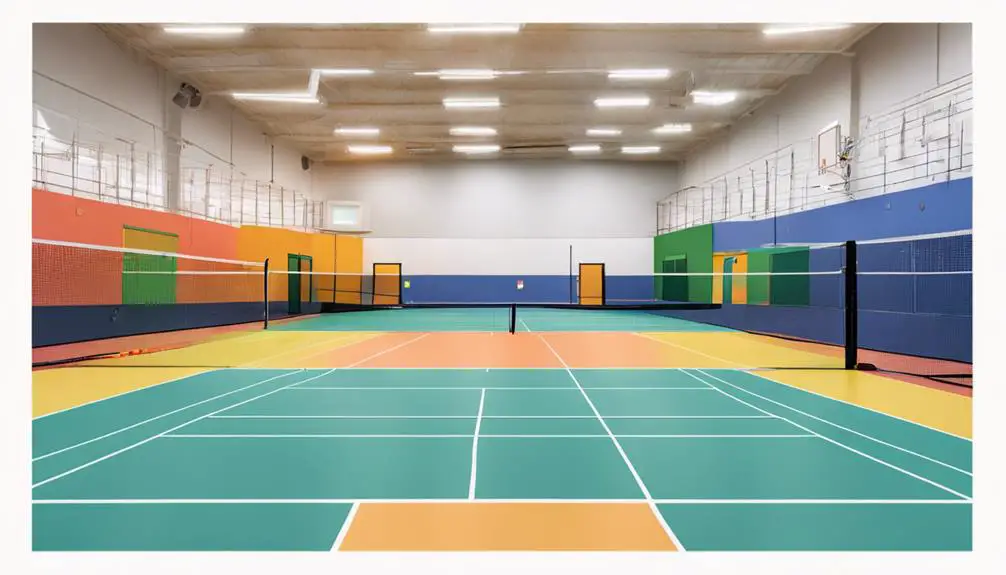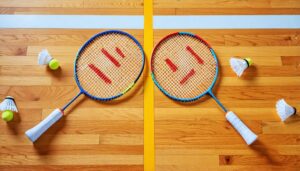When comparing a badminton court to a pickleball court, you’ll notice a few key differences despite their identical dimensions of 20 feet by 44 feet. Badminton requires a higher net at 5 feet, which challenges your timing and technique. In contrast, pickleball’s net is only 34 inches, making it more accessible and promoting strategic play. The surfaces also differ; badminton typically uses wooden flooring, while pickleball often features synthetic materials. Plus, equipment plays a role—badminton racquets are lighter and designed for precision, whereas pickleball paddles are heavier and more solid. To fully grasp the nuances, there’s plenty more to explore!
Court Dimensions Comparison
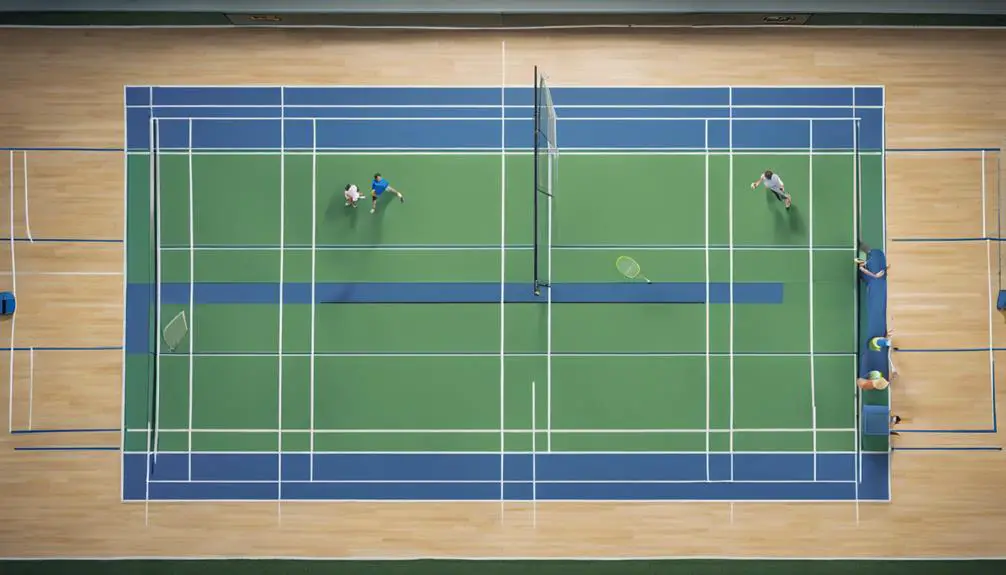
When it comes to court dimensions, one might find it interesting to compare badminton and pickleball courts, as they cater to different styles of play. Badminton courts measure 20 feet wide by 44 feet long for doubles, while pickleball courts are slightly larger at 20 feet wide and 44 feet long for singles and doubles alike. The differences lie not only in the dimensions but also in how these courts are used.
In badminton, the vertical space becomes essential, with high-flying smashes and dynamic footwork dominating the game. In contrast, pickleball emphasizes quick reflexes and strategic placement, often requiring players to stay closer to the ground. This affects how you approach court maintenance. A well-kept badminton court requires consistent attention to the net height and surface smoothness, while pickleball courts benefit from regular checks on the lines and overall playability.
Safety regulations also play a role in each sport. Badminton courts typically have stricter guidelines regarding overhead clearance, ensuring players have enough room to maneuver without risk of injury. Pickleball courts, however, focus more on the playing surface, as uneven ground can lead to slips and falls.
Understanding these differences not only enriches your appreciation for each sport but also highlights the significance of maintaining safe and functional playing environments. Whether you prefer the vertical challenge of badminton or the strategic play of pickleball, knowing the dimensions helps you enjoy every match to the fullest.
Surface Types and Materials
The surface type and materials of badminton and pickleball courts greatly influence gameplay and player experience. When you step onto a court, the surface can affect your agility, traction, and even your injury risk. Understanding these surfaces is crucial for players who crave freedom in their movements.
- Wooden Flooring: Commonly used for badminton courts, wooden surfaces provide excellent shock absorption and a smooth feel, promoting quick footwork. However, it requires regular maintenance to maintain its surface durability.
- Synthetic Surfaces: Pickleball courts often utilize synthetic materials, which can mimic the feel of grass or asphalt. These surfaces are renowned for their durability and lower maintenance requirements, allowing you to play more and worry less.
- Outdoor Courts: Both sports can be played on outdoor surfaces like concrete or asphalt. While these materials are incredibly durable, they might not offer the same level of grip or comfort, potentially leading to injuries.
- Multi-sport Surfaces: Some facilities use surfaces designed for multiple sports, which can be a great option if you enjoy variety. While these surfaces can be versatile, they may not provide the best experience for either badminton or pickleball.
Choosing the right surface is essential for maximizing your enjoyment and performance. Whether you’re gliding across a polished wooden floor or bounding on a synthetic court, the right material can make all the difference in your game.
Net Height Differences
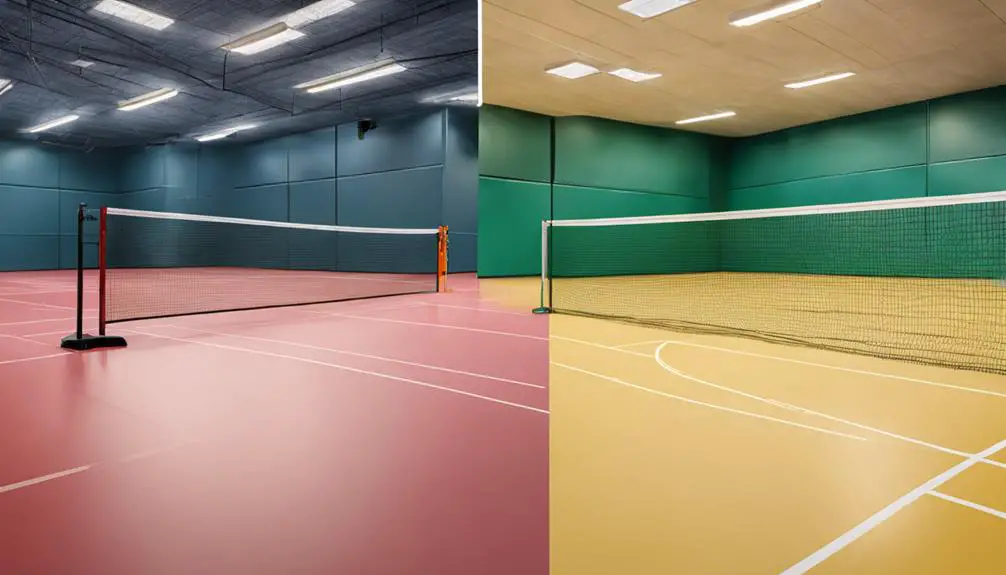
After selecting the right surface for your court experience, another important factor to take into account is the height of the net. This seemingly simple detail can greatly influence your gameplay in both badminton and pickleball. The net specifications differ markedly between the two sports, impacting how you approach your shots and strategies.
In badminton, the net stands at a height of 5 feet in the center, which can be quite a challenge for players with varying reach. If you’re taller, you might find it easier to clear the net with powerful smashes, while shorter players may need to rely on finesse and placement. The elevated height requires precise timing and skill, pushing you to master angles and control.
On the other hand, the pickleball net is set at 34 inches in the center, considerably lower than its badminton counterpart. This adjustment makes the game more accessible, allowing for fast-paced rallies and quick reactions. With the lower net, players can focus on strategic placements and volleys, rather than just power. The difference in net height also means that player reach becomes a vital factor.
Court Markings and Layout
Court markings and layout play a crucial role in defining the playing experience for both badminton and pickleball. Each sport has specific lines and dimensions that create a unique environment, influencing player movement and strategy. For enthusiasts looking to immerse themselves in either game, understanding these differences can enhance enjoyment and performance.
- Badminton’s Precision: The court is 20 feet wide and 44 feet long for doubles, with specific lines marking the service areas and out-of-bounds. This precision requires quick footwork and strategic positioning, making court maintenance important for safety and playability.
- Pickleball’s Flexibility: Pickleball courts are smaller, measuring 20 feet by 44 feet for both singles and doubles. This compact layout encourages dynamic rallies and quick reactions, allowing players to feel more engaged and free in their movements.
- Line Clarity: Clear, contrasting markings on both courts help players quickly identify boundaries. A well-maintained court guarantees that these lines remain visible, reducing confusion during fast-paced play.
- Player Flow: The layout directly impacts player movement. Badminton’s larger space encourages strategic play and agility, while pickleball’s smaller court fosters rapid exchanges and adaptability.
Gameplay Style Variations
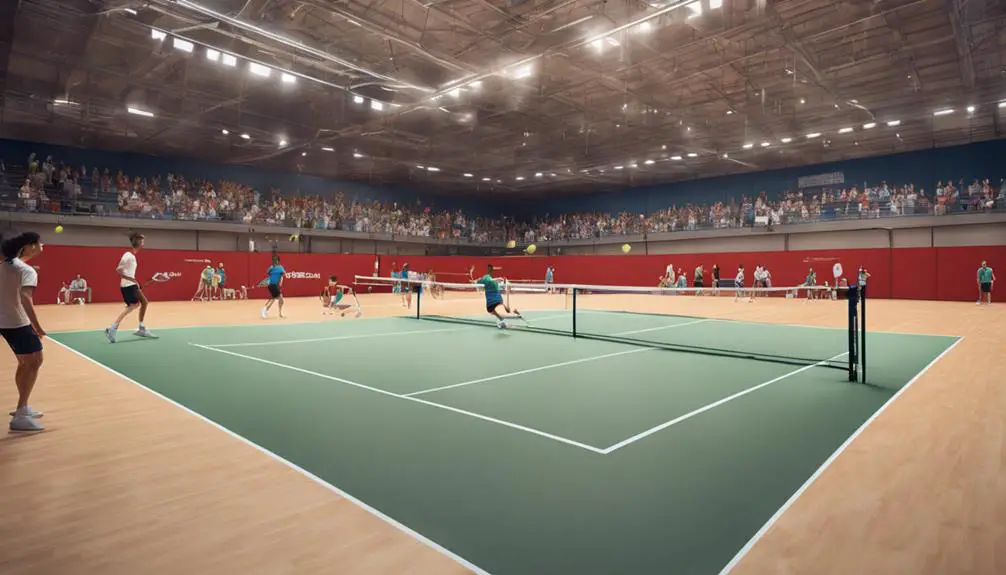
When you step onto the courts of badminton and pickleball, you’ll quickly notice that each sport demands a distinct gameplay style shaped by its rules and dynamics. Badminton emphasizes swift player movements and agility, requiring players to utilize quick footwork and reflexes to respond to the shuttlecock’s speed. You’ll find yourself dashing around, making sharp turns, and executing rapid smashes, which can be both exhilarating and exhausting. The scoring system in badminton, which uses rally scoring, means every point counts regardless of who served, adding an extra layer of intensity to each rally.
In contrast, pickleball offers a more strategic approach. The court is smaller, and the ball moves at a slower pace, allowing you to engage in longer rallies. You’ll notice that positioning and placement become essential as you aim for the best shot angles while anticipating your opponent’s moves. The scoring system in pickleball, which often includes only counting points when you serve, encourages a more tactical mindset. Player movements are less frantic, allowing for more thoughtful plays and positioning, which can lead to a different kind of satisfaction when executing a well-planned shot.
Both sports reward players for their unique skills—whether it’s the explosive agility needed in badminton or the strategic finesse required in pickleball. Whichever court you choose, you’ll find that each gameplay style offers a revitalizing and liberating experience that challenges your abilities in unique ways.
Equipment Differences
Understanding the equipment differences between badminton and pickleball can really enhance your playing experience. Each sport has its unique gear that impacts how you play, and knowing these distinctions can help you choose the right equipment for your style.
- Racket Types: Badminton rackets are lightweight and aerodynamic, typically weighing between 70 to 100 grams. They allow for quick movements and precision shots. In contrast, pickleball paddles are solid and heavier, made of wood or composite materials. This difference affects how you handle the ball and execute your shots.
- Ball Specifications: The badminton shuttlecock is feathered or plastic, designed to fly with great accuracy and stability. It’s sensitive to wind and requires skill to master. On the other hand, pickleball uses a plastic ball with holes, giving it a different bounce and flight pattern. This affects your strategy and shot selection, making the game feel distinct.
- Net Height: The badminton net stands at 5 feet in the center, while the pickleball net is lower at 34 inches. This height difference can change your approach to serving and volleying.
- Court Size: The badminton court is larger, measuring 20 by 44 feet, compared to the pickleball court’s 20 by 44 feet for doubles but shorter for singles. This affects how you move and position yourself during play.
Popularity and Usage Trends

The differences in equipment between badminton and pickleball not only influence gameplay but also reflect broader trends in their popularity and usage. In recent years, pickleball has surged in popularity, particularly among younger players and those looking for a low-impact sport. This trend reveals a shift in demographic preferences, with many seeking engaging activities that offer both social interaction and physical fitness.
Pickleball’s appeal lies in its simplicity and accessibility. It’s easier to learn, making it a favorite among beginners, families, and retirees. As you might notice, more community centers and parks are dedicating space for pickleball courts, reflecting regional growth that’s hard to ignore. In contrast, badminton, while still loved, tends to attract a more niche audience, often found in schools, clubs, and specialized facilities.
The regional growth of pickleball is particularly striking in the United States, where it’s often touted as the fastest-growing sport. With organizations promoting events and leagues, the sport’s visibility is on the rise. Badminton, however, maintains its popularity in certain cultures and competitive circles, especially in Asia and Europe.
Ultimately, the trends in popularity and usage reveal a landscape where pickleball is carving out a substantial niche, driven by accessibility and community engagement. As you explore these sports, consider how each one resonates with your personal preferences and lifestyle, and enjoy the freedom that comes with choosing the right activity for you.
Frequently Asked Questions
How Do Weather Conditions Affect Badminton and Pickleball Play?
Weather can twist your game like a windswept kite. Rain can slick court surfaces, affecting your footing, while extreme heat may wear down equipment durability. Always check conditions to guarantee your play remains free and enjoyable.
What Are the Health Benefits of Playing Badminton Versus Pickleball?
When you play badminton or pickleball, you boost muscle endurance and promote injury prevention. Both sports engage your body, enhancing cardiovascular health and coordination, while also providing an enjoyable way to stay active and fit.
Can Badminton and Pickleball Be Played Indoors or Outdoors?
You can play both badminton and pickleball indoors or outdoors. However, consider the court dimensions and playing surface; each sport requires specific measurements and conditions to guarantee peak performance and enjoyment for everyone involved.
What Age Groups Are Most Suited for Badminton and Pickleball?
When it comes to youth engagement, both sports fit the bill. Kids thrive in badminton and pickleball, fostering skill development from a young age. Older adults enjoy them too, keeping active and having fun.
How Do Cultural Differences Influence the Popularity of These Sports?
Cultural heritage shapes sport preferences, influencing which activities thrive in communities. You’ll find that community engagement and recreational trends often reflect local values, leading to varying levels of popularity for different sports across regions.

